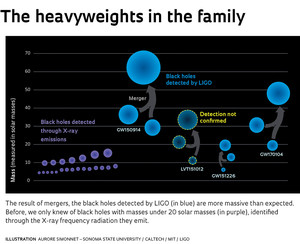
Aurore Simonnet – Sonoma State University / Caltech / MIT / LIGO
Artistic representation of two black holes merging and producing the gravitational waves detected by LIGOAurore Simonnet – Sonoma State University / Caltech / MIT / LIGOThe galaxies may contain a small, sparse population of black holes with masses much greater than those known until quite recently. These more massive black holes, with masses tens of times greater than that of the Sun, seem to form as a result of catastrophic, rare events: the collision and fusion of two less-massive black holes, detected for the first time in late 2015 by the instruments of the Laser Interferometer Gravitational-Wave Observatory (LIGO). In an article published on June 1, 2017 in the journal Physical Review Letters, the LIGO researchers describe the third recorded event of this type, which was also the farthest away.
The collision and fusion of black holes described occurred 3 billion light-years from Earth. It is the result of the collision between a black hole with 31.2 solar masses and another with 19.4 solar masses. The collision resulted in the birth of a black hole with 48.7 times the Sun’s mass. In the fraction of a second the event lasted, a colossal amount of energy was released—equivalent to that stored in the mass of two stars like the Sun—in the form of gravitational waves. Predicted by the general theory of relativity formulated in 1915 by Albert Einstein, these subtle space-time deformations propagate in the vacuum at the speed of light and traveled for 3 billion years to reach Earth. On January 4, 2017—at precisely 10:11 and 58 seconds UTC, or two hours earlier Brasília Time — LIGO’s two detectors, located 3,000 km apart in the United States, recorded the passage of this gravitational wave through the earth almost simultaneously.
This detection took place a few weeks after the start of the second LIGO data collection campaign, after its detectors were improved to become more sensitive. Earlier, two other direct detections of gravitational waves had been confirmed. The first was in September 2015, the result of the birth of a 62-solar-mass black hole 1.3 billion light years from Earth. The second was in December 2015, of a 21-solar-mass black hole that formed a little farther away, 1.4 billion light years from here (see bit.ly/GravOndas and Pesquisa FAPESP Issue Number 241).
“We have further confirmation of the existence of stellar-mass black holes that are larger than 20 solar masses,” stated physicist David Shoemaker of the Massachusetts Institute of Technology (MIT) in the press release announcing the third detection of a gravitational wave. He was recently chosen as the spokesperson for the LIGO scientific collaboration, which includes almost 1,000 researchers from different countries, including Brazil. “We knew nothing about these objects until LIGO detected them.
 Uncertain origin
Uncertain origin
Before, we only knew about stellar black holes, which resulted from the explosive death of stars, with masses of up to 20 solar masses. “They were completely different objects, found in our own galaxy, the Milky Way, that did not arise from the merger of binary black-hole systems,” says Italian physicist Riccardo Sturani, professor at the Federal University of Rio Grande do Norte, who, along with physicist Odylio Aguiar and his team at the National Institute for Space Research (INPE), is a LIGO collaborator.
Sturani is studying the dynamics of binary black-hole systems and the gravitational waves they produce when merging. “The black holes detected by LIGO are believed to have originated from the explosion of very massive stars,” says the Italian physicist. “But we still do not know if, in these pairs, the black holes arose from the explosion of stars that formed and remained near each other, or if the stars appeared separately and then drew closer together, each captured by the gravitational pull of the other.”
The results presented in early June 2017 are incremental and had less of an impact than those published previously by the LIGO group. Even so, they give us some clue as to what may have happened to the pair of black holes detected this year.
The shape of the gravitational waves emitted during the merger suggests that they were not spinning in the same direction before colliding, which would be expected if they had formed together. For this reason, they are suspected to have arisen independently within a large cluster of stars and only united later. “We are beginning to gather statistics on binary black-hole systems,” physicist Keita Kawabe of the California Institute of Technology (Caltech) told reporters. According to Sturani, another 20 or 30 events like these need to be detected in order to be able to say, with statistical significance, which of the two models describe what occurs in nature.
“The three LIGO detections of gravitational waves have begun to reveal that there is a population of these objects,” says physicist Rodrigo Nemmen of the Institute of Astronomy, Geophysics and Atmospheric Sciences at the University of São Paulo (IAG-USP), who is not involved with LIGO. He is studying the behavior of stellar black holes and states that LIGO’s results should lead to updates of stellar evolution models. “Important changes in knowledge, such as those produced by Galileo and Copernicus, were a consequence of advances in instruments,” Nemmen reminds us. “LIGO does the same by allowing us to study these very energetic phenomena that do not emit light and show us something we did not expect.”
Projects
1. Gravitational wave research (No. 13/04538-5); Grant Mechanism Young Researchers Program; Principal Investigator Riccardo Sturani (IFT-Unesp); Investment R$256,541.00.
2. Gravitational wave astronomy – FAPESP-MIT (No. 14/50727-7); Grant Mechanism Regular Research Grant; Principal Investigator Riccardo Sturani (IFT-Unesp); Investment R$29,715.00.
3. New physics from space: Gravitational waves (No. 06/56041-3); Grant Mechanism Thematic Project; Principal Investigator Odylio Denys de Aguiar (INPE); Investment R$1,019,874.01.
Scientific article
ABBOTT, B. P. et al. GW170104: Observation of a 50-solar-mass binary black hole coalescence at redshift 0.2. Physical Review Letters. June 1, 2017
